
|
Go to China Resources page
Go to Jordan's main page. Go to previous file, next file. |
Content Revised 2008-05-27 File last modified: |

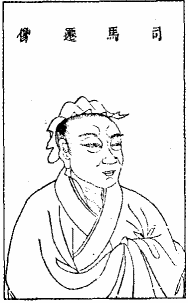 |
| Sīmǎ Qiān 司马迁, who died about 90 BC or so, was the official historian under Emperor Wǔ 武 (reign 06b-6), who had him castrated for offensive political advice. Rather than honorably committing suicide as anticipated, Sīmǎ Qiān continued to work on China's most famous book of history. |
Traditional Chinese historiography begins the story of Chinese civilization on the Central Plains 中原 about five thousand years ago with a period of the so-called "Five Emperors" 五帝 (although nine monarchs have been assigned to this period, period 01).
Our major textual source for many of these figures is a history of China called The Records of the Historian 史记, written by Sīmǎ Qiān 司马迁, who lived in the early Hàn 汉 dynasty [period 06b], a couple of thousand years after the people he described.
Although there are tales about each of these as a great, even miraculous, historical figure, their exact status is difficult to be certain about. Assuming the existence of these people, some of their "names" may in fact have been the names of groups, possibly dominant kinship or "ethnic" groups. For example, "the Yán Emperor" or "Emperor Yán" 炎帝 may have been the name of group of people — possibly a clan (definition)) or phratry (definition) — and not that of an individual person at all.
And indeed the title "dì" 帝 given to them, although later meaning "emperor," probably either was not used in their era or had an entirely different meaning.
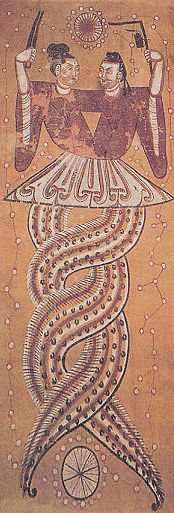 |
| Fú Xī and Nǚwā represented as intertwined snake people (excavated at Turfan [Tǔlǔfān 吐鲁番], Xīnjiāng [XJ]) |
The first of the great culture heroes was Fú Xī 伏羲 [reign 01a-1], also called Tài hào 太昊. Some suggest that Tài hào is a kind of dynastic title, and that his personal name was Fú Xī (or Páo Xī 庖羲). He was regarded as reigning for a thousand years, and his sister Nǚwā 女娲 is said to have invented humans, and then to have persuaded Fú Xī to enact mating restrictions on them, thus creating the institution of marriage.
The next leader, also considered to have reigned a thousand years or so, was Emperor Yán 炎帝 [reign 01a-2]. Also known by a "personal name" of Shén Nóng 神农 ("spiritual farmer") or Liè Shān 烈山 ("noble mountain"), he is considered to have "invented" agriculture.
Sīmǎ Qiān regarded the Yellow Emperor 黃帝 [reign 01a-3] as the founder of Chinese civilization, and even today Chinese will sometimes describes themselves as descendents of the Yellow Emperor.
The Yellow Emperor is said to have lived to the age of 117 and to have governed his realm for a full century. Like his predecessors, he is also credited with wonderful inventions, including clothing and medicine. (The "Yellow Emperor's Scripture of Internal Medicine" 黄帝内经 dates from the IVth or IIIrd century BC, but still invokes his name as a symbol of its association with the tradition of the invention of medicine.) And it is to his reign that tradition dates the invention of writing by a certain Cāngjié 仓颉, who is said to have been a brother of Fú Xī and to have had three sets of eyes, and after whom a Chinese-character input system for computers is now named.
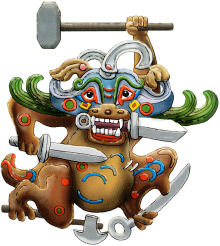 |
| Chīyóu as seen in a modern Hong Kong children's book. He has traditionally been represented as a kind of monster. |
Most Chinese historians today are inclined to think that the Yellow Emperor was a real person. He may have been a "tribal chief" 部落首领. Nearby, to the south and to the west, competing tribes would have corresponded to the Yán Emperor and to his nemesis, a "person" named Chīyóu 蚩尤, lord of a tribe called the Jiǔlí 九黎. Both Chīyóu and the Yán Emperor were traditionally held to have been the Yellow Emperor's enemies and competitors (and competitors of each other), against whom he fought and whom he eventually conquered. The Yellow Emperor's dominance over and alliance with the Yán Emperor to conquer Chīyóu became, according to legend, the basis for the unification of Chinese civilization, understood as centered forever on the middle and lower reaches of the Yellow River valley 黄河流域.
Two other major figures among the nine rulers of the "Five Emperors" period are Yáo 尧 (or Táng Yáo 唐尧 or Táo Táng 陶唐) [reign 01a-8] and Shùn 舜 [reign 01a-9].
From earliest times Yáo and Shùn were praised for their virtue, and Shùn is the first in the list of famous filial exemplars held up for imitation from late dynastic times to the present. He was so virtuous, we are told, that even wild animals came to help him plow his family land. Recognizing Shùn's high moral character, Yáo passed on the throne to him rather than to his own children. (The classic text on the twenty-four filial exemplars is available on this web site. Click here.)
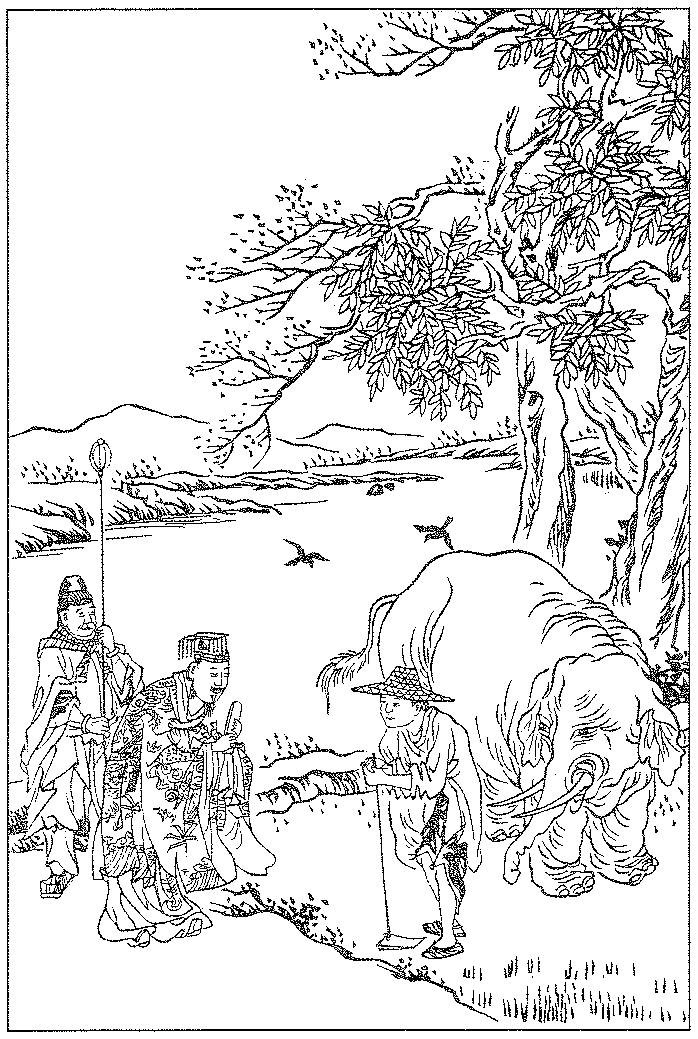 |
| Qīng Dynasty woodcut of Emperor Shùn, shown plowing with the assistance of an Elephant. (Click to enlarge.) |
Chinese scholars today tend to regard Táo Táng, Yáo's "title," as probably being the name of a group (possibly a clan) of which Yáo was a member. Shùn is sometimes called Yú Shùn 虞舜, and the same logic would make him a member of the Yú "clan," presumably an ally of the Táo Táng "clan."
Shùn in his turn, we are told, passed the throne on to a virtuous man named Yǔ 禹, who won great admiration for managing to control the flooding of the Yellow River (for which he is often called "Yǔ the Great" 大禹), who is considered the founder of China's first dynasty.
These legends tell us little of what really happened, of course. People don't suddenly invent clothes or agriculture or marriage, as these myths recount. Even if the great heroes and villains of these stories actually existed, they did not exist in the way that the stories represent them (which is perhaps another way of saying that they didn't exist).
What we know from archaeology is that people in what are today the various river systems of China had settled and taken up agriculture by about 8000 BC, roughly the same time in which agricultural adaptations developed over much of the rest of Eurasia after the retreat of the Würm glaciation. This period is called the Neolithic. (More About the Neolithic)
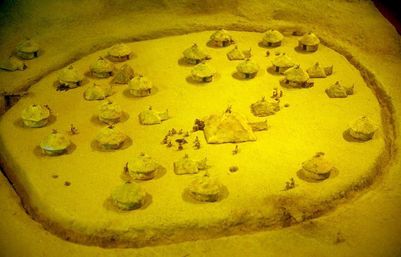 |
| Museum diorama of Bànpō, a Neolithic Village |
There are a great many Neolithic village sites now known. Among the most important, because it has been so thoroughly excavated, is Bànpō 半坡, a site that you can visit as a tourist in the city of Xī'ān 西安 in Shǎanxī 陕西 Province (the same city where your tour guide will take you to see the famous Underground Army, built during the reign of the first full-fledged emperor of China, Qín Shǐhuángdì 秦始皇帝 [reign 05a-1]).
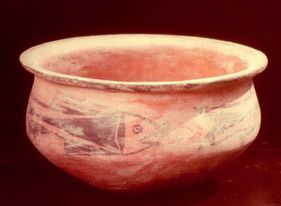 |
| Luxury pottery from Bànpō. The fish design, common at Bànpō, has been interpreted by some as a kind of logo for a "clan." |
Bànpō dates from about 4000 to 3000 BC and is part of the Yǎngsháo 仰韶 family of sites, named for a "type site" (definition) located in the core Yellow River region between about 5000 and 2700 BC. Like other Yǎngsháo sites, Bànpō exhibits ample pottery, often beautifully decorated, and materials used for hunting, fishing, and farming. The village is surrounded by a moat the function of which is unclear. It is unlikely that it would have provided very sustained defense against other people, especially in the absence of any sort of piling on the inside of it (such as one finds in norther European fortified settlements), so a good spculation is that it was designed to keep domestic animals where they belonged at night, and to keep wild animals out. (Some writers have argued that it shows the village was a clan settlement, but there is no obvious logic to support that.)
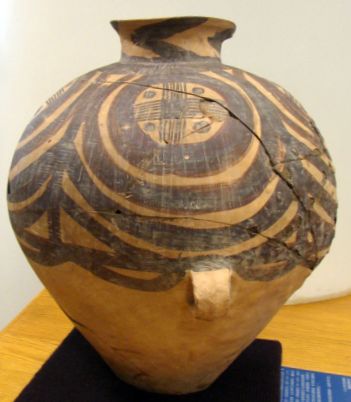 |
| Very late Yǎngsháo period, Mǎchǎng 马厂 style, pottery from Gānsù (GS) province, about 2500 BC. |
Buildings at Yǎngsháo sites can be reimagined based on the postholes preserved as discolorations in the soil, and they have a remarkable sameness about them, with two exceptions. One is that there is a mix of square and round structures with no obvious difference in function. And the other is that there is a very occasional, slightly larger structure, usually interpreted as a space for group activities. Bànpō conforms to this general pattern
Because Emperor Yǔ was succeeded (against his will) by his son, he has been regarded as the founder of the first Chinese dynasty, called Xià 夏 ("summer," a word which some people speculate once meant "elegant" or which may have referred to a kind of palace represented today by the character 厦).
Yǔ is credited not only with controlling the Yellow River floods, but, as monarch, with establishing cities, devising a system of appointed administrative officials, and setting up China's earliest code of laws. He is also traditionally considered to have established the first system of tribute exacted from surrounding peoples. The Xià, although not necessarily Yǔ's reign, is also credited by later writers with establishing prisons, a rationalized army, and an administrative calendar.
Review Quizzes Over This Page: Quiz 1A, Quiz 1B.
Go to previous file, next file.